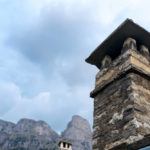Some things you just expect to start leaking, like a bike tire, for example. It doesn’t take long for an air mattress to spring a leak, either. But there are some things that just seem too durable to ever have a leaking problem, like your chimney. Such a sturdy structure seems made to last forever. Unfortunately, it can develop leaking problems over time, and if it does, it can cause serious damage to your living area and to some key components of the chimney and fireplace system. That’s why it’s so important to have your chimney inspected on a regular basis, or at least annually as recommended by the Chimney Safety Institute of America (CSIA).
How Do You Know Your Chimney Is Leaking?
If you’ve been noticing that your wallboard or trim around the fireplace is soft, stained, or peeling, there’s a good chance that your chimney is leaking. The same is true of the ceiling. Brown water spots indicate that there is a leak somewhere, and it’s highly likely that the leak is coming from your chimney or from a component of your chimney, like the chimney cap or the flashing. Another reason for concern is rusty chimney parts, such as the dampers or even your chimney accessories or fireplace door. You may even notice that the metal firebox is rusting or deteriorating, which indicates that the leak has been there for awhile.
If you take a look at the exterior of your chimney, there are signs of leaking there that can also be observed. You may notice that there is a grainy, sparkling layer on the bricks and mortar. This is efflorescence, which means that water that is coming through the pores of the brick and mortar is carrying salt through, which is then forming a layer on the exterior of your chimney. Efflorescence is a good indication that there is water present, and this can cause damage to your chimney system. Another indication that there is a problem is spalling. If there are white specks or flakes on the ground by the chimney, spalling is occurring. Water in the bricks and mortar is causing the surface to flake off, which can cause structural damage if left untreated.
What Damage Can Leaks Cause?
If you’re noticing brown, weak spots on your walls or ceilings, you’ll have some interior damage to correct before this weakening spreads. Leaks can cause other problems, such as cracks in the flue lining. If this occurs, dangerous chemicals from smoke might be finding their way back into your home. When leaks mix with creosote that is in your chimney, you may be getting a nasty odor that permeates your home. More seriously, however, you may notice that the structure of your chimney is being compromised, and your chimney may even begin to tilt.
Who To Call?
If you notice any of these things, it’s time to give Chimney Doctors of Colorado a call to inspect your chimney and determine the source of the leak. It’s best to catch and repair these leaks before they cause bigger problems with a more expensive price tag, and more importantly, affect your family’s health and safety!
